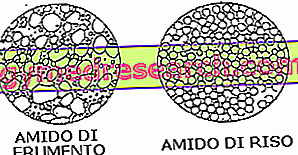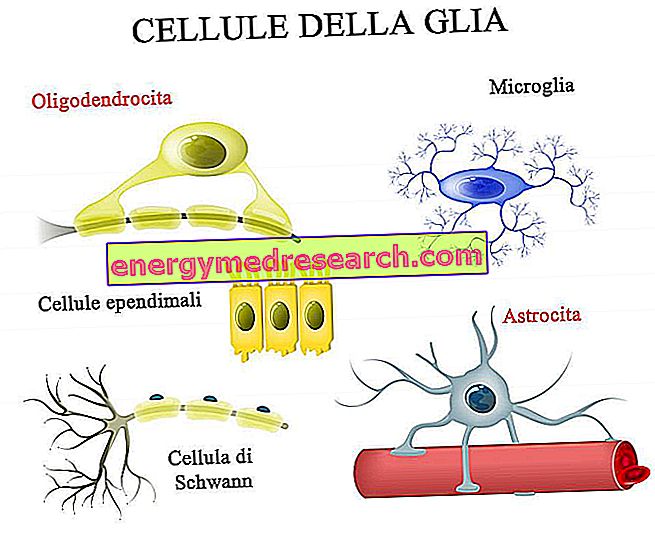Generality
Rice is a cereal consisting mainly of the caryopsis of Oryza sativa, an annual herbaceous plant belonging to the Poaceae family (Gramineae).

It is conceivable that rice was born 4, 000 years before the birth of Christ in Asia (China), near the Himalayan mountain range; from there it spread to the Middle East, Africa and Europe.
Today, rice is grown all over the world and meets 50% of food demands for the general population. In Italy it is produced mainly in Piedmont, Lombardy, Emilia Romagna and Veneto; secondly in Tuscany, Sardinia and Calabria.
In-depth articles
Venus rice - Black rice Integral riceRiso parboiledBasmati rice Fermented red riceRice Calories Rice or pasta? Rice starch Rice flour Rice rice oil Rice milkRice vs Pasta
Does rice offer rice advantages over pasta?
In our country, rice is an important, but often undervalued, alternative to wheat, while in Japan and China it provides on average about half the daily calories.
Let us then consider summarizing the main nutritional differences between the two foods, compared with the same refining.
Amount of protein
Pasta is richer in protein, while rice contains more starch; this means that during cooking the latter absorbs considerable amounts of water, up to triple its weight; for this reason, even if the two foods have more or less the same energy intake when raw, cooked rice is a less caloric and more satiating food than pasta. This characteristic is greater in the preparation of the "risotto"; in this case an additional caloric reduction takes place, thanks to the formation of the typical "cremina" based on starch diluted in water.
Gluten free
As we have already said, in rice the proteins are present in limited quantities; in particular, the percentage of prolamine is scarce and for this reason the peptides of the rice are not able to form gluten. It is therefore very difficult to produce rice paste, unless special ingredients used in industrial products are added. On the other hand, rice is perfectly tolerated by celiacs, who use it very often as a substitute for pasta.
Best biological value
The biological value of rice protides is slightly higher than that of wheat proteins. There is, in particular, a higher lysine content, which represents the essential limiting amino acid in cereals.
Greater digestibility
Rice is more digestible than pasta, because its starch is made up of small granules and does not cause the classic postprandial drowsiness. This parameter may be subject to variations depending on the cooking method (risottatura or drowning) and the presence of other ingredients (condiments, vegetables, meat, fish, etc.).

Poor allergenicity
Of all the cereals, rice has the least allergenic potential. Not by chance, it is used in the so-called elementary diets, specific for the search for poorly tolerated foods.
These are dietary regimes also called "exclusion diets", in which a nutritional journey is started with very few foods considered safe and the others are gradually integrated one by one, observing the reactions of the organism.
Integral: useful in case of diabetes
If integral, it can be used, but still with a certain moderation, even by diabetics; its glycemic index is in fact lower than that of pasta.
Suitable for phenylketonuria and hyperuricemia
Due to its modest protein content, rice is suitable for nephropaths and phenylketonurics; being an antiuric food, it is recommended by doctors to gout patients and in conditions of hyperuricemia.
processing
Rice processing process
Rice processing can be summarized as follows:
Rice cleaning
Rice processing includes a first cleaning step, in which all the foreign substances are eliminated through various passages in sieves, magnets, air jets, etc.
Hulling of rice
This is followed by a hulling phase (in which the glumella are removed, a sort of leaflets that wrap around the grain and which in the other cereals spontaneously detach when picked).
After these preliminary operations we obtain a brown rice - edible but which needs long cooking times - and a "waste", called lolla or rice husk.
Using the husk
The husk, once used in the preparation of feed or used in agriculture as a fertilizer, was then widely re-evaluated, so much so that today it assumes a high importance due to the high lipid content, which by extraction can give rice oil.
Rice whitening
The brown rice is then subjected to a bleaching, with the aim of eliminating the outer layers of the grain. This operation allows the removal of the germ and the detachment of the pericarp and the aleuronic layer, until obtaining the only amylifera almond.
The bleaching phase takes place through different steps, from which different types of products are obtained based on an increasing degree of refining:
- semi-refined rice
- merchant rice
- refined grade I rice
- refined grade II rice
Note : this distinction corresponds, so to speak, to the "type II, I, 0 and 00" names of the flours.
Rice flaring
After bleaching, final glazing is performed, ie a superficial treatment with glucose or oiling with vaseline oil, to give the beans the typical shine.
Nutritional properties
Nutritional characteristics of rice
Rice is a food that belongs to the III fundamental group of foods. As such, it is a nutritional source of energy from starch, fiber and specific minerals and vitamins.
The caloric intake is high, although it should be corrected for water absorption during cooking (around 200%). This means that, even if the uncooked (dried) rice brings 330-340 kcal / 100 g, the cooked one contains not more than 110-113 kcal / 100 g. Preparing it with the method of risottatura, assuming the absence of other ingredients and seasonings, could reach 85 kcal / 100 g.

Carbohydrates are complex, yet the glycemic index of refined rice is quite high. The same does not apply to the integral one.
Proteins have a medium biological value, even if the lysine content is higher than that of wheat. The fatty acids of the brown rice are of excellent quality and the level of essential polyunsaturated is appreciable.
Rice contains a variable percentage of fiber, which is double in brown rice compared to white rice.
Cholesterol is absent.
With regards to vitamins, the integral one is rich in thiamine (vit B1), niacin (vit PP) and vit E (alpha-tocopherol). The relative concentrations decrease in the parboiled and refined product. The same is true for mineral salts, of which magnesium, iron and phosphorus are particularly applied.
Rice is an ingredient widely used in vegetarian and vegan diets, but not in raw food. It does not contain gluten and lactose; furthermore, as already specified, it is considered a hypoallergenic food.
The abundance of brown rice fibers makes it suitable for the diet against constipation, but contraindicated in diet for diarrhea. Furthermore, the fibrous component of this food accompanies a fair amount of anti-nutritional (phytate) molecules which, if not effectively subjected to heat, could decrease the concentrations of magnesium, iron and calcium.
Rice is suitable for almost all diets; it is necessary to reduce the average portion and the frequency of consumption in case of overweight, type 2 diabetes mellitus and hypertriglyceridemia. The adequate amount of rice could be about 80 grams dry weighed (260-270 kcal).
Main nutritional differences of white and whole rice
As you can see by looking at the table below, the nutritional properties of a brown rice are better, because during the milling process many fibers, mineral salts (mainly located at the pericarp level) and vitamins (concentrated in the aleuronic layer) are lost.
To realize the nutritional importance of brown rice, just think that the introduction of the glaze in Asian regions, at a time when local food was almost exclusively based on rice consumption, led to the appearance of beriberi, a disease caused due to vitamin B1 deficiency (thiamine). This substance, in fact, is largely lost in the polishing process, while it is kept in important concentrations in brown and parboiled rice.
Edible part (%) | Polished rice | Brown rice | Parboiled Rice |
Energy (Kcal) | 332 | 337 | 337 |
Water (g) | 12.0 | 12.0 | 10.3 |
Proteins (g) | 6.7 | 7.5 | 7.4 |
Lipids (g) | 0.4 | 1.9 | 0.3 |
Available carbohydrates (g) | 80.4 | 77.4 | 81.3 |
Starch (g) | 72.9 | 69.2 | 73.6 |
Soluble sugars (g) | 0.2 | 1.2 | 0.3 |
Total fiber (g): | 1.0 | 1.9 | 0.5 |
Insoluble fiber (g): | 0.89 | 1.80 | ND |
Soluble fiber (g): | 0.08 | 0.12 | ND |
Sodium (mg) | 5 | 9 | 9 |
Potassium (mg) | ninety two | 214 | 150 |
Iron (mg) | 0.8 | 1.6 | 2.9 |
Calcium (mg) | 24 | 32 | 60 |
Phosphorus (mg) | 94 | 221 | 200 |
Thiamine (mg) | 0.11 | 0.48 | 0.34 |
Riboflavin (mg) | 0.03 | 0.05 | 0.06 |
Niacin (mg) | 1.30 | 4.70 | 3.9 |
vitamin E (mg) | tr | 0.7 | tr |
Phytic acid (g) | 0 | 0, 252 | ND |
Video Recipes with Rice
Cantonese rice
X Problems with video playback? Reload from YouTube Go to Video Page Go to Video Recipes Section Watch the video on youtubeOther Proposals
- Risotti for All Tastes - The Best Video Recipes
- Recipes with rice
- Recipes with puffed rice
- Recipes with brown rice
- Recipes with venere rice
- Recipes with basmati rice
- Recipes with fragrant fragrant jasmine variety rice
- Recipes with rice flour
- Recipes with rice milk
- Recipes with sushi rice
- Recipes with rice vinegar
Rice: commercial varieties »


